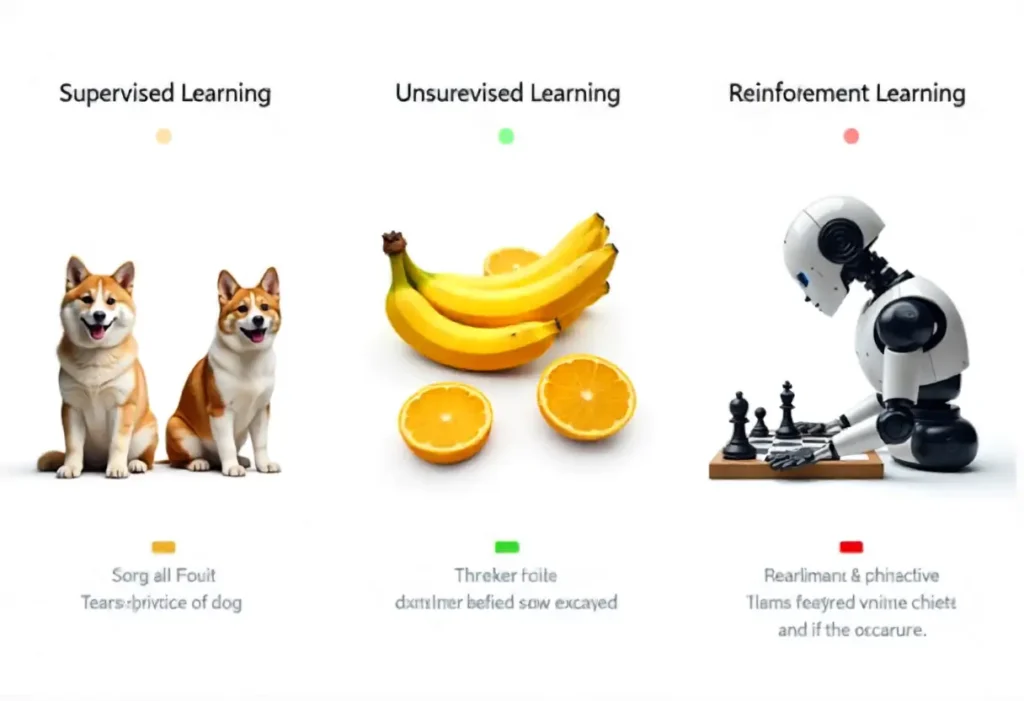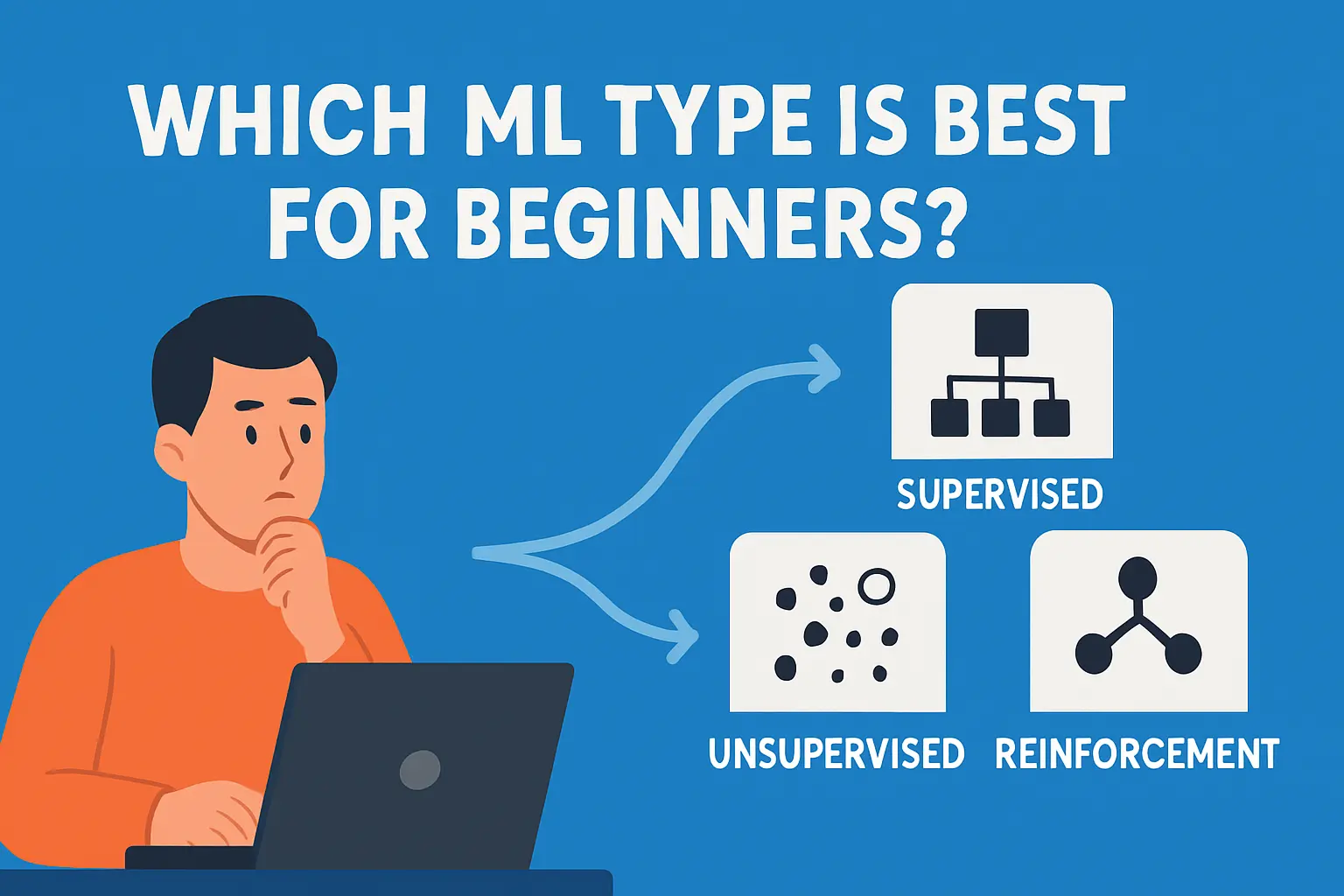Machine learning is rapidly expanding. Everyone wants to learn it. Not every type of machine learning is approachable.
When you are only starting, it is good to select the appropriate type. Some are simple, some are hard. Selecting the most appropriate one would save time and assist you to learn quicker.
In this case, we are going to consider machine learning types beginners. We are going to describe each of them and demonstrate which one is the simplest to begin with.

Table of Contents
What Is Machine Learning?
Machine learning refers to the method of educating computers on the basis of data. Computers detect patterns in data, instead of specific instructions given to them.
In my case, you can train a computer to identify cats in photographs. You give it many cat pictures. The computer is taught what a cat is.
There are three types of machine learning:
- Supervised Learning
- Unsupervised Learning
- Reinforcement Learning
Another more recent form, which we will also mention, is the so-called Semi-Supervised Learning.

1. Supervised Learning
Beginners find supervised learning the least difficult.
In a supervised learning, you provide the computer with data and correct answers. The computer gets to know how to correlate information with responses.
For example:
Pictures you have of cats and dogs.
You inform the computer of the pictures which are cats and which are dogs.
- The computer gets to know how to identify new pictures.
Supervised learning is effective in:
(house prices, stock values) prediction of numbers.
- Grouping things (spam emails, types of animals)
- Pattern recognition (fraud recognition, weather forecasting)
Why it is good for beginners:
- You can see clear results.
- It uses common datasets.
There are numerous tutorials and examples.
Algorithms most frequently used in supervised learning:
- Linear Regression
- Logistic Regression
- Decision Trees
- Random Forests
- Support Vector Machines
2. Unsupervised Learning
Learning without supervision is more difficult than learning under supervision.
In this case, you enter the data in the computer without labelling. Patterns have to be discovered by the computer.
For example:
— You have store customer data.
You do not inform the computer of any groups.
- The computer identifies groups of the similar customers.
Unsupervised learning is applied to:
- Finding hidden patterns
Grouping (customer segmentation) items. - Reducing data size
- Recommending products
The reason it is more difficult with beginners:
- No correct answers are given
- It is more difficult to verify whether the results are correct or not.
Algorithms are sometimes difficult to figure out.
Widely used unsupervised algorithms:
- K-Means Clustering
- Hierarchical Clustering
Principal Component Analysis (PCA), a subdivision of principal component analysis (PCA), is a statistical method that quantifies the associations and connections among multiple variables, which are then utilized to forecast the missing variable.<|human|>Principal Component Analysis (PCA) Principal Component Analysis (PCA) is a statistical method, and a sub-division of principal component analysis (PCA), a statistical method that measures the relationships and the relationship between multiple variables, which it then uses to predict the missing variable.
3. Reinforcement Learning
The most difficult type of learning is reinforcement learning.
In this kind, the computer is learning through trial and error. It is rewarded when it does the right thing and punished when it does the wrong thing.
For example:
You train a robot on how to play chess.
When it makes a good move it scores.
- It loses points for bad moves.
With time, it gets to know the optimal approach.
Reinforcement learning can be applied in:
- Robotics
- Game AI
- Self-driving cars
Why it is hard for beginners:
- It needs a lot of data
- Programming is complex
- Results take time to appear
4. Semi-Supervised Learning
Semi-supervised learning is a combination of the supervised and unsupervised learning.
In this case, you provide a certain amount of labeled data and an amount of unlabeled data. Both are used to learn on the computer.
For example:
You are provided with 100 labeled cat pictures and 1000 unlabeled pictures.
and the computer learns by the labeled ones, and makes guesses at the unlabeled ones.
It comes in handy where it is costly or time consuming to label data.
For beginners:
- A bit more difficult than guided learning.
Easier than learning on your own. - Good for real-world projects

Comparing The types of machine learning as a beginner.
| Type | Difficulty | Best For | Notes |
|---|---|---|---|
| Supervised Learning | Easy | Prediction, classification | Most beginner-friendly |
| Unsupervised Learning | Medium | Pattern finding, clustering | Harder to validate results |
| Reinforcement Learning | Hard | Games, robotics | Needs lots of trials and patience |
| Semi-Supervised Learning | Medium | Real-world projects | Mix of labeled and unlabeled data |
This is the reason why beginner learners should begin with the supervised learning.
- Very easy instructions: You are aware of the correct answers.
- Simple datasets: The simplest datasets are readily available on the Internet.
- Quick feedback: You get success within a short time.
- Numerous instructions: There are numerous step-by-step instructions on the Internet.
- Establishes the basics: You understand the basic principles of regression, classification, and evaluation.
The following types are simpler to comprehend when one begins with supervised learning.
These are the tools suggested to beginners.
You do not need a supercomputer. A large number of tools are easy to use:
- Python: Most used machine learning language.
- Scikit-Learn: Fantastic library of supervised and unsupervised learning.
- Pandas: Processes data and analyzes it.
- NumPy: Assists with calculation and numbers.
- Jupyter Notebook: Code step-by-step interactive tool.
These are the tools that assist in the learning of any type of machine learning by a beginner.
These are some of the tips I would suggest to learn machine learning.
- Begin with small tasks: Forecast housing prices or sort flowers.
- Focus on one type at a time. Supervised learning first.
- Exercise every day: Little exercises are good.
- Work with online datasets: Kaggle, UCI Machine Learning Repository or Google Datasets.
- Know how to visualize data: Graphs are used to learn patterns.
- Self check: Compare predictions and correct answers.
- Questions on forums: Stack Overflow, Reddit or AI communities.
Conclusion
Supervised learning is the most appropriate point of beginning in case of beginners.
It is simple, convenient and commonplace. Once you have learned it, you can attempt unsupervised or semi-supervised learning as well as reinforcement learning.
It is important to keep in mind that learning machine learning is a process. Begin with small projects, do it frequently, and do more challenging ones.
Concentrating on the types of machine learning as an entry-level user, you can develop a solid background and can take the next step in projects without fear.
Frequently Asked Questions
Q1. Which type of machine learning is the easiest to use?
The simplest is the supervised learning. You provide the computer with the data having correct answers.
Q2. Is it possible that beginners can first learn unsupervised learning?
It is possible, but harder. Novices have a tendency to fail at result validation.
Q3. What are some of the tools used by beginners to learn machine learning?
The Python, Scikit-Learn, Pandas, NumPy, and Jupyter Notebook are most suitable to beginners.


1 thought on “Which Ml Type Is Best For Beginners?”